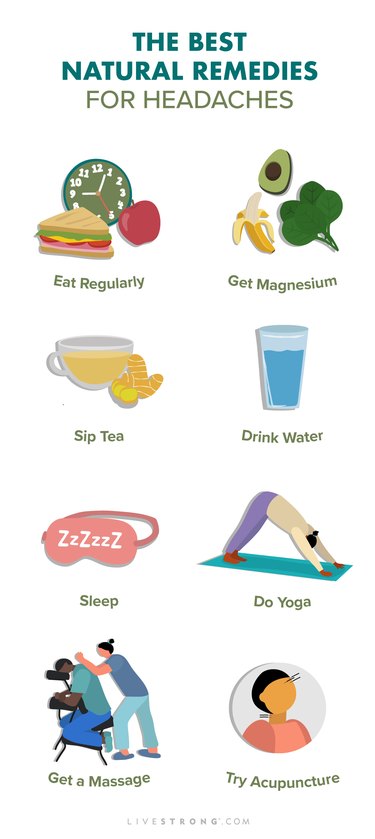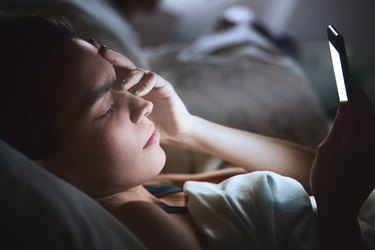

Headaches are an all-too-common annoyance. At best, they can make even simple daily tasks more challenging. At worst, they can leave you curled up in bed for hours.
The good news is if you're not a fan of taking Tylenol on a regular basis, there are plenty of natural remedies for headaches, including some small lifestyle changes, certain foods and hot or cold therapy.
Video of the Day
Video of the Day
But before you cure a headache naturally, it helps to understand why your head hurts in the first place.
What Causes a Headache?
Headaches occur when specific nerves send pain signals to your brain. They can be hereditary, or triggered by environmental factors like eating certain foods, drinking alcohol or breathing in perfumes or other strong smells, according to the Cleveland Clinic.
Types of Headaches
There are different types of headaches, too. Some of the most common, according to Stanford Medicine, include:
- Migraine headache: The pain is typically on one side of your head, and may be accompanied by sensitivity to light and sound, vision changes and nausea or vomiting that lasts up to 72 hours.
- Tension headache: The pain is usually around the back of your head, forehead and temples, and may feel like pressure that lasts from hours to days.
- Cluster headache: The pain stays on one side of your head for 20 minutes to two hours, but it may come back many times a day up to several weeks, then go away for weeks or months. You might also notice a stuffy nose on one side and watery eyes.
Keep reading for 18 medication-free ways to get rid of a headache quickly (or stop it from coming on in the first place).
1. Eat Regularly
Good Evidence"This is good advice for everyone, really, but especially for migraine sufferers," says Vernon Williams, MD, board-certified neurologist and director of the Center for Sports Neurology and Pain Medicine at Cedars-Sinai Kerlan-Jobe Institute in Los Angeles.
Don't skip meals, and add in a snack or two throughout your day (with plenty of protein) so you don't go more than a couple hours without eating. This way, you won't experience those big drops in blood sugar that can bring on an achy head, Dr. Williams says.
Having regular daily meal times is associated with less frequent migraines, according to the American Migraine Foundation (AMF). And the longer you go between meals, the higher your chance of getting a headache.
2. Get More Magnesium
Good EvidencePeople who get headaches have lower levels of magnesium, so the AMF suggests taking a 400- to 500-milligram supplement of magnesium oxide every day to prevent them.
If you don't want to take a supplement, try adding more foods high in magnesium to your diet, including:
- Spinach
- Pumpkin seeds
- Black beans
- Quinoa
- Brown rice
- Flaxseeds
- Dark chocolate
- Avocado
- Bananas
3. Drink Plenty of Water
Good EvidenceSometimes the simplest solution is the one that's easiest to forget. Dehydration is a major "migraine catalyst," so drinking a glass of water might be enough to get rid of a headache fast, according to Dr. Williams.
The AMF suggests drinking water throughout the day instead of soda, juice or other sugary drinks. A good guideline is to drink half your body weight in ounces of water each day. So, if you weigh 180 pounds, for example, try to drink about 90 ounces, or just over 11 cups, daily. (Tea and coffee count!)
4. Get Enough Sleep
Good EvidenceIt often seems like getting a good night of shut-eye is the solution to many ailments, but this is especially true when it comes to headaches.
"Lack of sleep or disordered sleep are common headache triggers," Dr. Williams says. "Maintaining a regular sleep schedule and getting enough have been shown to help lessen the headache occurrences and severity for many sufferers."
For the record, most adults need between seven and nine hours of sleep per night, according to the Centers for Disease Control and Prevention. Easier said than done sometimes, though, right? But there are a few things you can do to get more zzzs in your life: Start with this seven-day kickstart plan.
5. Do Some Yoga
Good Evidence"Research indicates that regular, moderate aerobic exercise can reduce the severity, duration and in some cases the number of migraines people experience," Dr. Williams says. But one form of exercise that might be especially beneficial is yoga.
Yoga has been shown to reduce stress, and stress is one cause of headaches. One May 2020 study in Neurology found people who completed a three-month yoga routine showed greater improvements in headache relief than those who used medication alone.
If you're new to the practice, you might want to start with some simple poses that focus on breathing, such as child's pose or cat cow:
Child's Pose
- Start by kneeling on a mat or soft surface.
- Place your hands on the mat, then slowly push your bottom back onto your heels.
- With your arms stretched out in front of you, palms on the mat, lower your forehead to the mat so your chest and abdomen are against your upper thighs (you can spread your knees if that's more comfortable).
- Hold for 30 seconds or as long as feels good to you.
Cat Cow
- Start on all fours with your knees under your hips and your hands under your shoulders.
- Draw your navel in toward your spine and arch your back like a cat.
- Starting at your tailbone, begin to extend your spine, vertebra by vertebra, until you are in a swayback position.
- Continue slowly alternating between the two for 30 seconds or as long as feels good to you.
6. Limit Screen Time
Good EvidenceToo much screen time can cause neck tension and interfere with sleep, both of which are common causes of headaches.
Dr. Williams recommends taking frequent breaks from your computer and smartphone screens to give your eyes a rest.
And while you may not be able to do much about your screen time during work hours, try to cut down on time spent in front of the TV or looking at your phone after work hours, and especially during the hour or two before bed.
7. Drink Less Alcohol
Good EvidenceA night of overindulging can lead to a mind-numbing migraine in the morning. One April 2020 study in Annals of Medicine found drinking five or more servings of alcohol makes people twice as likely to have a headache the following day.
There was no association with one or two servings, but if you're a heavy drinker, it's just one more reason to cut back on the booze.
8. Don’t Go Cold Turkey on Caffeine
Good EvidenceIf you've recently cut back on your coffee consumption or quit java altogether, caffeine withdrawal might be the culprit behind your headaches.
"Caffeine withdrawal is a common cause of headaches and occurs in individuals who regularly drink more than five cups of coffee a day and suddenly stop their caffeine intake," says Michael Richardson, MD, a primary care doctor in Boston.
Instead of abstaining entirely, Dr. Richardson recommends swapping out that morning cappuccino for a cup of green tea (which has less caffeine) in order to wean yourself off slowly. Here are three more tips to help you cut back without the painful side effects.
9. Keep a Journal
Good EvidenceIt sounds strange, but one of the best natural remedies for headaches is to figure out what's causing them. One way to do this is to keep a journal, Dr. Williams suggests.
"When a headache comes on, write down what you did that day or the day before that might have triggered it," he says. "After a few entries, you may begin to see a pattern emerge that will help you stop a headache in its tracks next time. It's worth the effort."
10. Sip Some Ginger Tea
Some EvidenceGinger is most often recommended as a natural remedy for nausea, but it's also a home remedy for head pain relief. A November 2020 meta-analysis of randomized controlled studies in The American Journal of Emergency Medicine found eating ginger was a source of headache relief.
The root can be used in a variety of dishes but can also be enjoyed as a sweet, herbal tea. To make it at home, peel and thinly slice a 1-inch piece of ginger and add it to a saucepan with a cup of water. Bring the mixture to a boil, then simmer it for five to 10 minutes. Strain the tea and serve it with a bit of honey and a slice of lemon.
11. Get a Massage
Some EvidenceMassage the muscles in the back of your head, neck and shoulders, or ask someone else to do it for you. Massage can help break up tension headaches for some people, according to the Mayo Clinic.
12. Try Acupuncture
Some EvidenceThis traditional Chinese medicinal practice — which involves placing tiny needles at strategic points on the body — has been shown to reduce a wide variety of pain. An April 2017 study in JAMA Internal Medicine showed a significant reduction in migraine attacks following a 24-week trial.
13. Use Essential Oils
Some EvidenceSome research shows certain essential oils can help stop headaches fast. One April 2012 placebo-controlled trial in European Neurology found sniffing lavender oil to be a very effective way to manage migraine headaches.
Other scents that may help include peppermint, rosemary, eucalyptus and chamomile.
To use essential oils to relieve a headache, you can put them in a diffuser, place them in a pendant around your neck or add a few drops to an ounce of coconut oil and rub it into your temples.
14. Apply a Cold Compress
Some EvidenceIt might seem a little old-school, but some research — including a July 2013 randomized controlled trial in Hawaii Journal of Medicine & Public Health — has shown cold therapy can be a good way to get rid of a headache.
Instead of wrapping up ice in a bag and lying still while you try to balance it on your forehead, it might be worthwhile to invest in a disposable gel cooling patch or compression cold wrap headband to pull out of the fridge as needed.
15. Apply a Warm Compress
Some EvidenceIf cold therapy doesn't do the trick, try changing the temperature.
Apply a warm compress to your forehead and the back of your neck to relax the muscles around your temple and scalp and stimulate blood flow around the area, which is helpful for a tension headache, per the Mayo Clinic.
Once again, buying a heating pad or hot pack will most likely get you more long-lasting results than filling a bottle with hot water, and it's safer. A warm bath or shower could help, too.
Try This Warm Compress
Dr. Jeff's Hot + Cold Pain Relief Pack ($29.99, Amazon)
16. Avoid Chewing Gum
Some EvidenceHeadaches caused by temporomandibular disorders (TMD) can present with pain in your temples on one or both sides of your forehead, and the pain is intensified when you clench or grind your teeth.
To relieve these types of frontal headaches, the National Institute of Dental and Craniofacial Research suggests avoiding chewing gum and other similar jaw movements. Also, ask your dentist about simple jaw exercises that can help reduce this kind of head pain.
17. Take B2 Vitamins
Limited EvidenceThere's a limited amount of research indicating vitamin B2, or riboflavin, can help with migraines. One December 2015 review in Vitamin and Nutrition Research did conclude that B2 vitamins "play a positive role in reducing the frequency and duration of migraine attacks with no serious side effects." The dose for adults was typically 400 milligrams daily.
These vitamins can also serve as healthy antioxidants that help increase your energy levels, so it might be worth giving them a shot. Just make sure to talk to your doctor first, and go with a vitamin brand you can trust.
Vitamin B2 is also naturally found in the following foods, according to the Harvard T.H. Chan School of Public Health:
- Dairy products, including milk, yogurt and cheese
- Eggs
- Chicken breast
- Lean beef and pork
- Salmon
- Almonds
- Spinach
18. Ask About Other Supplements
Limited EvidenceCertain dietary supplements may help treat headaches, according to the National Center for Complementary and Integrative Health (NCCIH), but they may also cause side effects or interact with other medications you're taking, so be sure to talk to your doctor before adding any supplement to your routine.
The supplements with the most evidence for headache relief, per the NCCIH, are:
- Butterbur
- Coenzyme Q10
- Feverfew
When to Talk to a Doctor
Some headaches should not be treated at home. If you have any of these headache symptoms (some of which could be stroke symptoms), per Harvard Health Publishing, call your doctor:
- New headaches that start after age 50
- Unusually severe headaches
- Headaches that hurt more when you cough, move or bend over
- Headaches that get steadily worse
- Headaches with fever or stiff neck
- A headache that comes after a blow to the head
- Headaches that include any change in speech or vision
"If you are treating your own headaches three or more times per week, ask for help from a headache specialist," says Michael Doerrler, DO, an assistant professor of neurology and a headache specialist at Loyola University Medical Center in Chicago. "You may need more than simple measures."
- American Migraine Foundation: "Migraine and Diet"
- American Migraine Foundation: "Magnesium"
- The American Journal of Emergency Medicine: "The efficacy of ginger for the treatment of migraine: A meta-analysis of randomized controlled studies"
- Centers for Disease Control and Prevention: "How Much Sleep Do I Need?"
- Annals of Medicine: "Prospective cohort study of daily alcoholic beverage intake as a potential trigger of headaches among adults with episodic migraine"
- JAMA Internal Medicine: "The Long-term Effect of Acupuncture for Migraine Prophylaxis"
- European Neurology: "Lavender essential oil in the treatment of migraine headache: a placebo-controlled clinical trial"
- Hawaii Journal of Medicine & Public Health: "Randomized Controlled Trial: Targeted Neck Cooling in the Treatment of the Migraine Patient"
- Mayo Clinic: "Migraines: Simple steps to head off the pain"
- Harvard T.H. Chan School of Public Health: "Riboflavin – Vitamin B2"
- Harvard Health Publishing: "Headache: When to worry, what to do"
- Mayo Clinic: "Tension Headache"
- National Center for Complementary and Integrative Health: "Headaches: What You Need To Know"
- Cleveland Clinic: "Headaches"
- Stanford Medicine: "Types of Headache"
Is this an emergency? If you are experiencing serious medical symptoms, please see the National Library of Medicine’s list of signs you need emergency medical attention or call 911.

